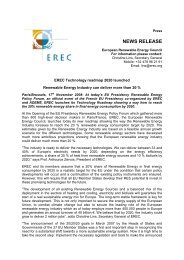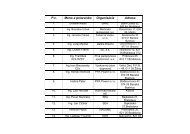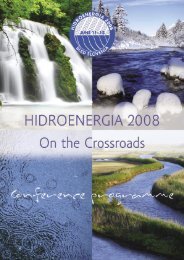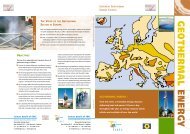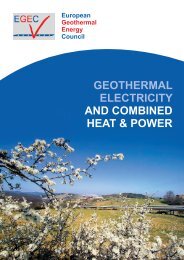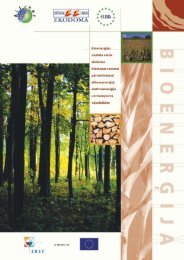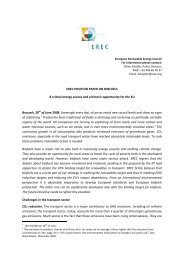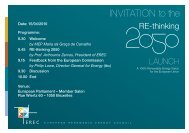CTO Assessment - European Commission
CTO Assessment - European Commission
CTO Assessment - European Commission
You also want an ePaper? Increase the reach of your titles
YUMPU automatically turns print PDFs into web optimized ePapers that Google loves.
MOLINS DE CAMPOS<br />
Mills of the past<br />
winds of the future<br />
Contact: Pascual Tortella • Adjuntament de Campos<br />
Plaza Mayor, 1 • 07630 Campos • Majorca • Tel.: +34 629 43 94 91<br />
E-mail: molinsdecampos@terra.es<br />
The project of Campos is an excellent alliance<br />
between the heritage from the past<br />
and the new technologies of the future, a<br />
multidisciplinary project joining heritage<br />
restoration, landscape maintenance, windenergy<br />
production, search of new tourist<br />
products integrated and adapted to the environment<br />
and the recovery of local traditional<br />
productions.<br />
The characteristics of the Balearic Islands’<br />
agricultural development have partly been<br />
determined by the archipelago’s climatic<br />
conditions. Windmills were built to overcome<br />
irrigation problems due to a lack of<br />
surface rivers and streams. The type of<br />
windmill found in Majorca is based on designs<br />
that date back to Alexandrian times<br />
and the first windmills reached Europe<br />
from Persia in the 11 th century.<br />
During the middle Age, the number of windmills<br />
grew. Most were flourmills, but there<br />
were also watermills. All had rotors with<br />
sails of fabric. Windmills were not really<br />
put to use to extract water from the ground<br />
until 1845, with the work of the Dutch<br />
engineer Paul Bouvy and the plan to drain<br />
the plain known as the PIA de Sant Jordi.<br />
From then on, there was a spectacular increase<br />
in number. There are well over two<br />
thousand windmills on the island of Majorca.<br />
Main aims<br />
The “Molins de Campos” project was created<br />
as a result it is the result of a partnership<br />
between the RES and the heritage.<br />
For this reason, the project does not only<br />
involve the windmills’ structural restoration<br />
‘ but it also has a global environmental<br />
objective: to convert the windmill into a<br />
generator of wind energy - a clean, renewable<br />
source of energy - whilst also carrying<br />
out a series of parallel activities within the<br />
immediate vicinity, focused on promoting<br />
the use of windmills and their adjacent lands<br />
in ways which will lead to the generation of<br />
income and a number of different economic<br />
activities, within the framework of the sustainable<br />
use of natural resources and the<br />
protection of the environment.<br />
The global idea of the project seeks not<br />
only the architectural restoration and obtaining<br />
wind power, but also to make the<br />
mills turn into reference elements for tourist<br />
use, as centres for craftsmanship and<br />
valorisation of the rural products of the<br />
area.<br />
Overall evaluation<br />
Having carried out the experimental study,<br />
in the light of the excellent results achieved,<br />
it was necessary to continue with the initial<br />
objectives. With this in mind, given the<br />
high cost involved in the restoration of the<br />
windmills, it was decided to start by concentrating<br />
on a first stage of the “Molins<br />
de Campos” project, which would focus on<br />
a group of about one hundred windmills.<br />
The mills recovering process especially<br />
cared after energy aspects, that meant a<br />
far from negligible technological challenge,<br />
since the project’s engineering had to resolve<br />
aspects such as adapting traditional<br />
rotors to present-day generators, within<br />
investment conditions that allow investment<br />
recovering in an acceptable time space.<br />
The restoration of the cultural heritage<br />
that the windmills represent and the<br />
recovologically-friendly produce).<br />
The initiative<br />
There are four main aims behind the<br />
project, which is planned to focus on a figure<br />
of about 100 windmills:<br />
The restoration of the windmills, in their<br />
capacity as a part of historical heritage,<br />
thus reducing and indeed improving the<br />
negative visual, aesthetic and environmental<br />
impact of the windmills that presently<br />
exist in the area.<br />
The conversion of the windmill, by introducing<br />
technology that will take advantage<br />
of the island’s wind energy, and<br />
the introduction of a new innovation, the<br />
small-scale production of electricity for<br />
use, energy-saving and, indeed, to replace<br />
other sources of energy.<br />
The creation of a sustainable environment<br />
in association with the windmill,<br />
using the resources of the surrounding<br />
area. Designing and creating the most<br />
suitable type of outdoor gardens and<br />
guaranteeing, above all, Majorca’s<br />
biodiversity by the use of native island<br />
species of plants.<br />
Parallel activities, which help to guarantee<br />
the feasibility of the project as a<br />
whole. Introducing the concept of sustainability<br />
to rural farms and to the development<br />
of tourism and cultural attractions.<br />
Results<br />
More than 100 windmills have been restored<br />
until the present. Currently it is being<br />
widening the initiative with the project<br />
of a visitors center (RES and Heritage).<br />
Enabling factors<br />
Support of Ministry of Environment.<br />
Good perception by the creation of a new<br />
tourist product.<br />
Reinforcement factor of the local economy<br />
and the rural productions.<br />
Challenges<br />
Administrative processes for connection to<br />
net and need to unify the maintenance services.<br />
<strong>CTO</strong> - Showcase<br />
73



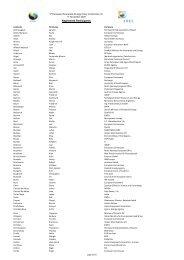
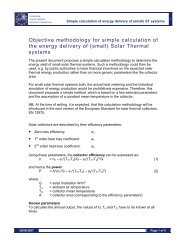
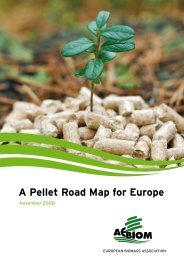
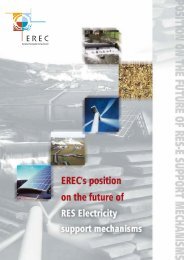

![Energy [R]evolution - Greenpeace](https://img.yumpu.com/47174859/1/184x260/energy-revolution-greenpeace.jpg?quality=85)
